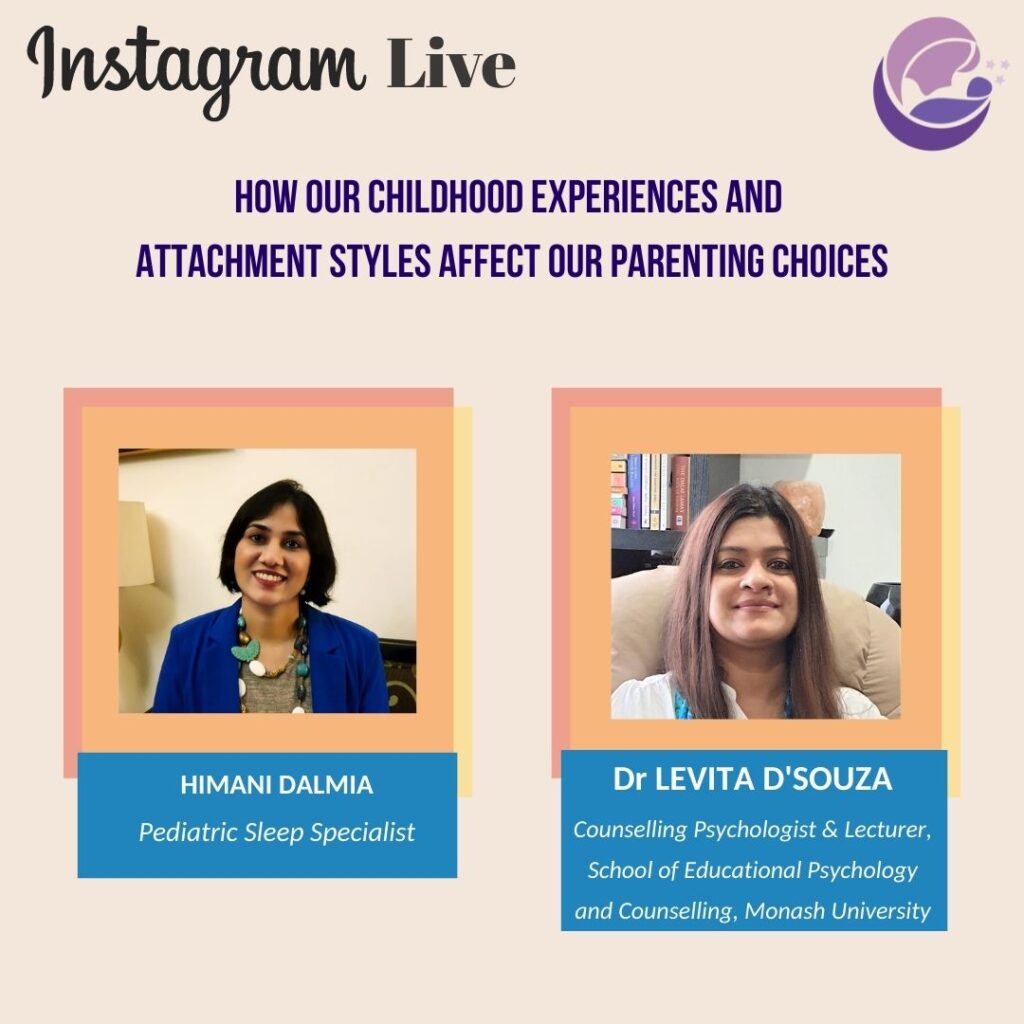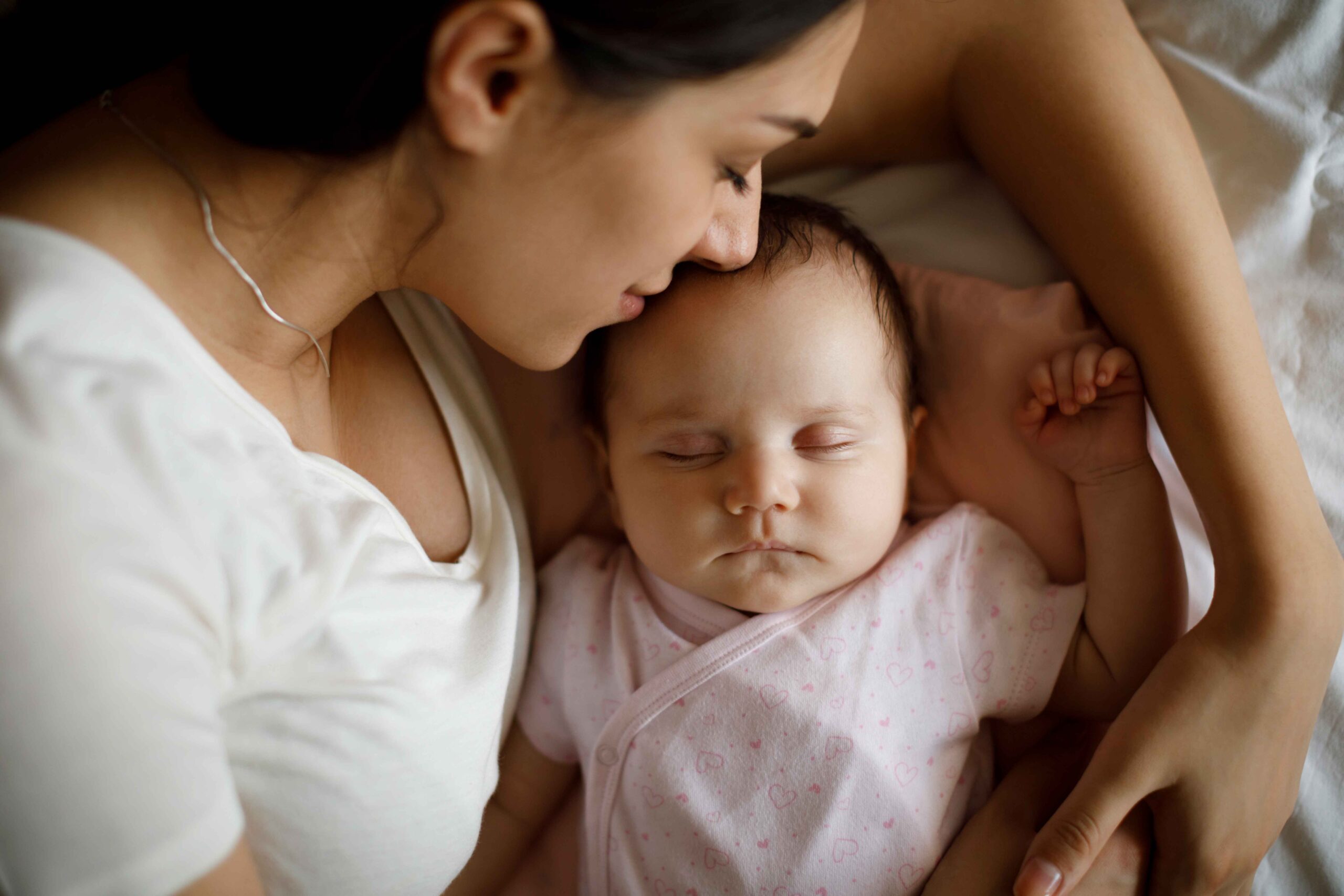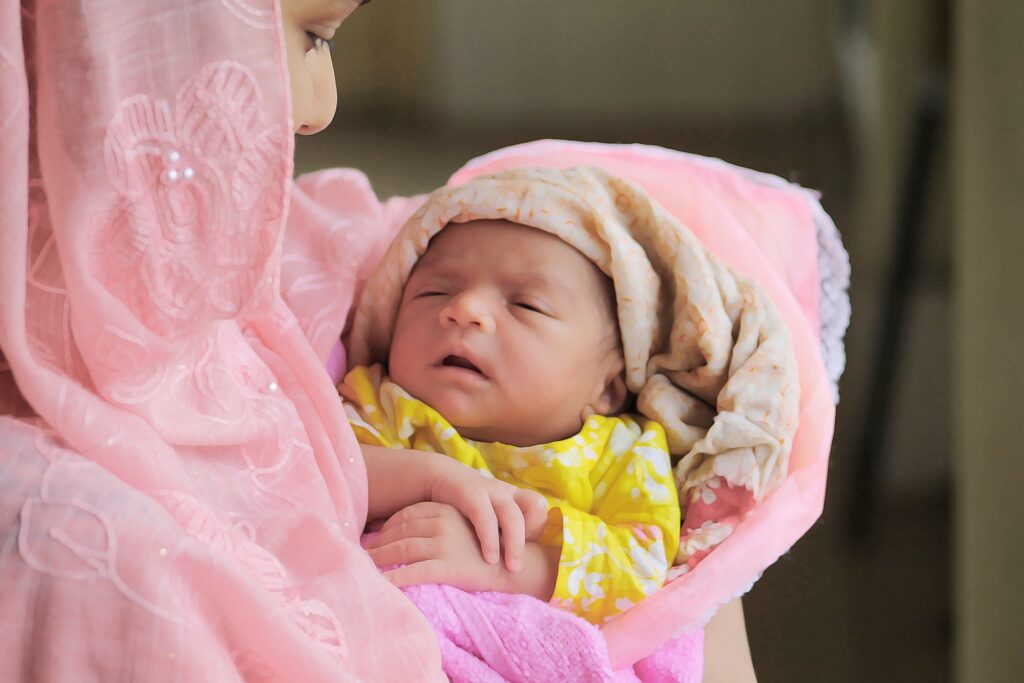Instagram Live with Dr. Levita D’Souza

Instagram Live with Dr. Levita D’souza I had a riveting conversation with Counselling Psychologist and Researcher, Dr Levita D’Souza, on Instagram Live, where we talked about attachment theory, attachment styles, how our own childhood experiences affect our parenting choices, ruptures and repairs in the bonding process with our babies and children, how parentj g is an opportunity for personal growth and much more! Unfortunately, there were some disturbances in the audio. So that Levita’s amazing insights don’t get lost, I am sharing a transcript for the conversation here. Do read through until the very end so that you don’t miss some transformative truth bombs! How our childhood experiences and attachment styles affect our parenting choices. Himani: Hi everyone. Thank you for joining in for this live with Levita D’Souza. I’m super excited because every conversation I have with Levita is just full of these truth bombs that she tends to drop. Levita is a Registered Counseling Psychologist and Lecturer within the Faculty of Education at Monash University in Melbourne, Australia. Her research interests are in the area of perinatal psychology, adverse childhood experiences and its impact on attachment patterns and subsequent parenting practices. Within this space, her current research projects are looking at psychological factors affecting first-time fathers as they transition to fatherhood and father-child bonding. She’s also undertaking research on cultural influences on parenting choices in relation to infant sleep. So that’s really where Levita and I have had many conversations – where infant sleep is concerned. And, as an Indian living in a sort of industrialized, westernized – “westernized”, not “Western” – country, I’m sure you’ve faced this dichotomy and perhaps that was one of the factors that drew you towards this research. So, could you tell us a little bit about your journey and what drew you to your current work? Levita: Yes, I think my journey first started with my quest and questioning around mental illness. Why people are mentally ill; if it runs in families, does it mean I’m doomed; does it mean that we cannot do things differently. And that led to my early work in my early study working with families where there has been mental illness. And what I found was that some outcomes were much better than others. So, for some patients, the outcomes were much better than others. And the same sort of thing was replicated when I was working with children who had experienced trauma. You know, crap happens to everyone. But some children were better able to deal with the trauma and overcome it or manage their symptoms compared to others. And what I could see clearly was those early sorts of parenting experiences. And it wasn’t till I became a mum myself and I started to question why – who am I as a mother? What kind of a mother do I want to be? What from my own parenting experiences do I want to bring into how I parent my child? What do I not want? – that I started to really dabble in this thing of attachment theory and how that can influence – those really early experiences can influence – later outcomes for children. And so then I’ve landed in this space where, very crudely, I say “how not to be a jerk of a parent”. That’s what the transition to parenthood is. What influences us, what will help us be better parents? What do we draw on? What do we not draw on? What do we want to leave behind? And attachment, I think plays a big role in that. Himani: So, you know, just for some of us and the uninitiated and the layperson, the lay parent rather, could you very simply explain attachment theory – what you spend years teaching your students – in about two minutes? (laughter) Levita: I’ll try. I will try. I was reflecting on this and going, “can I reliably do it?” But I’m going to try this. So, very simply… Himani: You can take ten minutes. I’m joking about the two minutes. Levita: Thank you! Much appreciated (laughter). So, very simply, it’s like a bond. It’s a bond that exists between the baby and the caregiver. For the purpose of this talk, I will interchange between “caregiver” and “mother” but I want to absolutely acknowledge that families come in all forms and so it can be the father, it can be the grandmother, or any caregiver who is consistent, who is reliable, who is dependable, who is sensitive, and who is able to attune to the baby in a timely sort of way. And so, what is attachment? It’s a bond between the baby and the caregiver. Why does it exist? It exists purely and solely for the purpose of survival. So, when the baby is born, the baby is born with a system, what we call a “bio-behavioural system”, which it uses to cue the parent that they need things, to meet their needs. So, let’s take an example, here’s a little baby. They experience hunger, and they experience hunger on a very physiological level, right, it’s a biological behaviour. That hunger puts the baby’s system in chaos. It experiences pain. The baby doesn’t immediately cry. What the baby might do earlier to cue the parent would be root, stick their tongue out, put their hand to their mouth, and these are, sort of, very early signs where the baby is cuing in the caregiver to say, “Mamma, look at me, I have a need, I’m expressing this, attune to me, meet my need, make me feel good.” When the baby does that, the mother goes, “oh, you’re hungry! You want me to pick you up, let me feed you.” When the mother meets that need, the baby’s system – that had started to be in chaos because of the hunger – returns to this really calm, nice, happy place. Mum feels good because baby has stopped crying; baby feels good because baby’s needs
Baby Sleep 101: The basics of baby sleep

Baby Sleep 101: The basics of baby sleep It is only after we become parents that we realize what a rocky road baby sleep is and how there is just so much learn and unlearn as we meet our baby’s biological needs while getting some rest ourselves! Let’s talk about some of the basic concepts of baby sleep. Why is sleep important for your child? Whether you have a baby or a toddler, sleep plays an important developmental role. Sleep is as important as food and, yet, somehow it does not receive the same mindful attention from parents. Often, parents are advised to let the child stay up until they drop off to sleep or to skip nap times to have an early bedtime or to reduce nightwakings. This advice usually backfires but is also developmentally potentially harmful. Good sleep is important for physical growth (the growth hormone is secreted during sleep), lower chances of obesity, heart protection, stronger immunity (proteins called cytokines, the building blocks of immunity, are produced during sleep), better attention spans, greater ability to learn and higher brain growth amongst other things. Night sleep and day sleep have different functions so naps play a vital role as well. What is “Sleep Parenting”? A commonly asked question is, “Don’t children just sleep when they are tired?”. The answer is no. The first step to sleep parenting is acknowledging that parents have to support the child to sleep. We help our babies to eat, bathe, play, walk, learn, talk and, yet, somehow we assume that parenting ends when the baby is asleep. This is where many things go wrong as our babies actually continue to need parenting when they sleep. Sleep parenting involves : Observing cues: Babies and toddlers show sleep cues in stages. It is important to observe for early sleep cues (see chart). When intercepted early, it is easier to make the baby/ toddler sleep than when the cues are not understood and the baby/toddler reaches the crying, overtired phase. An overtired child resists sleep and does not sleep well. Feeding or rocking to sleep: It is biologically normal for babies and young toddlers to sleep while nursing/bottle feeding and rocking/walking. These are not “bad sleep habits” or “bad sleep associations”. It is biologically normal for babies to need assistance in this regard and that too with active soothing methods such as these (patting does not work until much later). Children under 3.5 – 4 years cannot be expected to fall asleep on their own. Follow a child-led approach to trying different soothing methods. Holding while asleep: Young babies often wake when put down. They have a biological survival instinct that makes them seek the comfort and security, which comes from physical contact. If your baby is waking up when put down (either immediately or a few minutes later), we need to take the hint and keep holding them This is one vital example of how parenting does not end when the baby is asleep. Babies often need to be held for up to 10-11 months and during regression phases even after. This is biologically normal and not a bad habit. They outgrow the need when they are ready. Further reading on this: Why Does My Baby Wake Up When I Put Her Down? – Bellybelly.com.au When Your Child Will Only Nap On You – Sarah Ockwell-Smith Helping to go back to sleep: If your concern is that your 5 month old or 1 year old doesn’t nap more than 30 minutes at a stretch, the solution is to “bridge the nap”. When your child takes brief naps it doesn’t mean that her/ his nap is complete. It means that the child needs help in going back to sleep through active means of soothing. Bedsharing: Bedsharing is safe and normal and often leads to better sleep for the child and parents. There is much evidence on the benefits of bedsharing as well. For example, see Professor James McKenna’s research: https://neuroanthropology.net/2008/12/21/cosleeping-and-biological-imperatives-why-human-babies-do-not-and-should-not-sleep-alone/ Following baby’s schedule: A baby’s sleep schedule – based on the baby’s cues and natural biological rhythms – is sacrosanct. It works much better if adults adapt to the baby’s schedule rather than the other way round. Creating the right sleep environment: A pitch dark and quiet room for both daytime naps and night sleep (after the age of 3 months in particular) are vital to good sleep. These are biological needs as babies are very easily stimulated and jerked out of sleep. These do not form “bad habits”. What is Overtiredness? A child is overtired when she/he is awake beyond the age appropriate awake window. The child’s body recognizes that sleep isn’t coming and secretes the stress hormones cortisol and adrenaline to cope with it. The child experiences a “second wind”, wherein the child snaps back to wakefulness and becomes hyperactive. Does your baby/ toddler get over active when it is time for bed? Does she/he resist bedtime even though they look tired? Does your child often cry before sleeping? All these are classic examples of overtiredness. An overtired child does not sleep well, which can lead to multiple night wakings, including active nightwakings. Sleep Cues and Awake Windows Every baby is unique but babies of the same age range have similar sleep needs because it is biologically determined, like any developmental milestone. Looking out for sleep cues is important to determine when the child is ready to sleep. Babies and toddlers have early and late sleep cues, and the earlier a caregiver responds to sleep cues and soothes a child to sleep the better because late sleep cues lead to sleep resistance and disturbed sleep – also signs of overtiredness. Please refer to the chart above to understand what cues to look out for. “Awake window” means the time in between two naps or between naps and night sleep when a child can stay awake and interact without getting overtired. The
Should I follow the EASY routine?

Should I follow the EASY routine? No! Please follow the exact opposite. The “Eat – Activity – Sleep – You” routine is a pet concept of sleep trainers. It is heavily marketed as a quick-fix mantra for baby sleep but is, in fact, such a bizarre concept that it is really no wonder that millions of flummoxed parents try to follow it but find themselves either failing miserably or entering a never-ending cycle of training and disconnected parenting. The EASY routine is based on the idea that babies should eat (nurse/bottle feed), then play or engage in some activity and then sleep. Basically, they should not “feed to sleep”. The logic being that a baby who feeds to sleep will develop a “bad sleep association” and will need feeding after every sleep cycle to sleep again. This is totally senseless for so many reasons, starting with: 1. Babies are biologically programmed to feed to sleep. The suckling motion promotes sleep. Breastmilk contains sleepy hormones that help baby sleep. In fact, feeding to sleep is nature’s perfectly designed solution to baby sleep. 2. Babies may in fact even get hungry while they sleep. 3. Babies WANT to feed to sleep and will inevitably cry or resist sleep if denied the breast or bottle. This will lead to a cycle of sleep training. 4. Babies do wake at the end of sleep cycles and feeding is one of the easiest ways to help them enter the next sleep cycle. The idea that they will “self-soothe” if they do not have a sleep association is unscientific as babies are incapable of self-soothing. Oh, and please do not miss the YOU at the end. Apparently, once the baby is asleep, it’s free time for YOU. And somehow, I doubt sleep trainers mean enjoying an audiobook while holding your sleeping baby or taking a nap for yourself next to said baby! Nothing as comforting to the baby as that.
Should I put my baby down “drowsy but awake”?

Should I put my baby down “drowsy but awake”? The short answer: NO. The idea that one should put baby down “drowsy but awake” and hence “break sleep associations” or “teach baby to sleep on her own” is a pet concept of most sleep trainers. The idea is that, since all babies – like adults – wake at the end of a sleep cycle, they should find themselves in the same conditions that they fell asleep in, otherwise they will cry for those conditions to be recreated. The common example that is cited is: imagine you have fallen asleep on a nice, comfy bed (aka in your parents’ arms, being rocked or at the breast) and then you wake up and find yourself on the kitchen floor (the crib or bed) – would you not be upset? So, babies should not fall asleep at the breast because they will then want it every time they wake and will not be able to fall back asleep on their own. I find this example very confusing. Here we are clearly saying that the equivalent of the comfy bed is the breast or the parents’ arms. And yet….we want our babies to fall asleep on the kitchen floor?? This is just a fancy marketing gimmick. It sounds logical but it’s based on outdated behaviourist theory – that if you do something repeatedly, the baby will get used to it. We know now that parental soothing is a biological need. Babies cannot “get used to” not having it. What they can get used to is the idea that crying will not achieve anything and so they should experience the stress but internalize it. Several sleep experts absolutely dismiss the entire idea of “breaking sleep associations”. Firstly, very few babies actually accept the whole “drowsy but awake” thing without protest and some amount of crying. I know that mine would be instantly wide awake if I ever tried anything like that. We would then be back to square one in the soothing to sleep process and baby would then be overtired. Even if your baby accepts it and manages to complete the falling asleep process on her own, there is no guarantee that he will wake less frequently or that not having a parent-dependent sleep association means they can bridge sleep cycles on their own. Breaking sleep associations is a form of sleep training. It’s basically trying to teach a baby to “self-settle”, which is unscientific as babies don’t have a developed prefrontal cortex (thinking brain) that would allow this kind of logical reasoning. I have seen so many parents get so anxious about why their baby isn’t falling asleep drowsy but awake. And it causes babies stress too. That’s because it’s totally unscientific and goes against the basic instincts of both parents and babies. Providing a baby the correct, age-appropriate form of soothing and practicing sleep parenting works much more beautifully and pays off hugely in the end.
